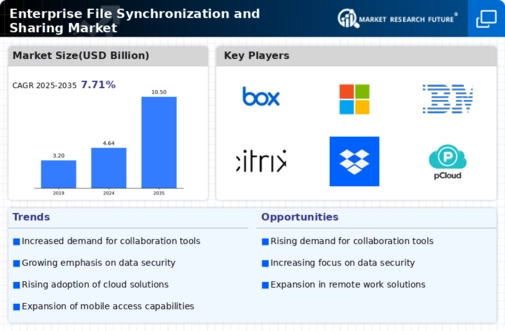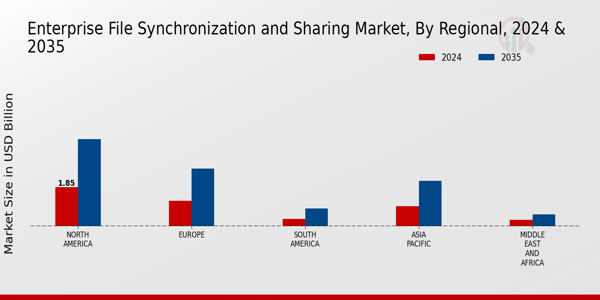Increased Mobile Device Usage
The proliferation of mobile devices has significantly influenced the Enterprise File Synchronization and Sharing Market. With employees increasingly relying on smartphones and tablets for work-related tasks, there is a pressing need for solutions that support mobile access to files. Data suggests that over 50 percent of employees use mobile devices for work purposes, highlighting the importance of mobile-friendly file synchronization tools. Organizations are seeking solutions that provide secure access to files on-the-go, ensuring that employees can remain productive regardless of their location. This trend is likely to drive innovation within the Enterprise File Synchronization and Sharing Market, as vendors develop mobile-optimized platforms that cater to the demands of a mobile workforce.
Growing Need for Collaboration Tools
The growing need for collaboration tools is a pivotal driver in the Enterprise File Synchronization and Sharing Market. As teams become more diverse and geographically dispersed, the demand for platforms that facilitate real-time collaboration has surged. Research indicates that organizations that utilize collaborative tools experience a 30 percent increase in productivity. This trend underscores the necessity for effective file synchronization and sharing solutions that enable seamless communication and project management. Consequently, vendors in the Enterprise File Synchronization and Sharing Market are focusing on developing features that enhance collaborative capabilities, such as version control and simultaneous editing, to meet the evolving needs of businesses.
Integration of Advanced Technologies
The integration of advanced technologies, such as artificial intelligence and machine learning, is transforming the Enterprise File Synchronization and Sharing Market. These technologies enable enhanced data management, predictive analytics, and automated workflows, which streamline file sharing processes. For instance, AI-driven solutions can analyze user behavior to optimize file access and sharing protocols. This technological evolution not only improves efficiency but also enhances security measures by identifying potential threats in real-time. As organizations increasingly recognize the value of these innovations, the Enterprise File Synchronization and Sharing Market is likely to witness a surge in demand for sophisticated solutions that leverage cutting-edge technologies.
Rising Demand for Remote Work Solutions
The increasing trend towards remote work has catalyzed the growth of the Enterprise File Synchronization and Sharing Market. Organizations are seeking efficient solutions to facilitate collaboration among distributed teams. According to recent data, approximately 70 percent of companies have adopted remote work policies, necessitating robust file synchronization and sharing tools. This shift has led to a surge in demand for platforms that ensure seamless access to files from various locations while maintaining security protocols. As businesses prioritize flexibility and productivity, the Enterprise File Synchronization and Sharing Market is poised for significant expansion, driven by the need for reliable and user-friendly solutions that support remote collaboration.
Emphasis on Data Security and Compliance
In an era where data breaches are increasingly common, the Enterprise File Synchronization and Sharing Market is experiencing heightened scrutiny regarding data security and compliance. Organizations are compelled to adopt solutions that not only facilitate file sharing but also ensure the protection of sensitive information. Regulatory frameworks, such as GDPR and HIPAA, impose stringent requirements on data handling practices. As a result, companies are investing in secure file synchronization tools that offer encryption, access controls, and audit trails. This focus on security is likely to drive innovation within the Enterprise File Synchronization and Sharing Market, as vendors strive to meet compliance standards while enhancing user experience.


















Leave a Comment